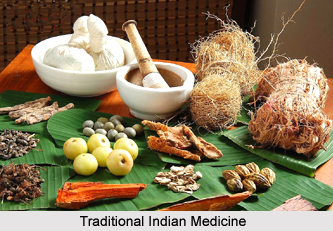 Traditional Indian medicine in later modern period faced several hurdles in the path of development. The disciplinary conflict of the indigenous medicine men, the control of the state faculty of West Bengal (1937) on the exercise of this system, indifference of the present generation and piracy of the western druggists were some of the major problems that the traditional medicine endured. In the first half of the twentieth century ayurveda suffered serious obstacles. Two separate groups were formed by the patrons of this system, shuddhapanthi and mishrapanthi. The mishrapanthi supported the idea of involving medical technology along with traditional medicine but the shuddhapanthi opposed their theory. Gananath Sen, Kaviraj Bijoy Ratna Sen and Jamini Bhusan Roy were a part of the mishrapanthi group and Kj. Pravakar Chottopadhyay, Kaviraj Shyamadas Tarkachuramani and Kj. Birnalananda Tarakatirta belonged to the shuddhapanthi.
Traditional Indian medicine in later modern period faced several hurdles in the path of development. The disciplinary conflict of the indigenous medicine men, the control of the state faculty of West Bengal (1937) on the exercise of this system, indifference of the present generation and piracy of the western druggists were some of the major problems that the traditional medicine endured. In the first half of the twentieth century ayurveda suffered serious obstacles. Two separate groups were formed by the patrons of this system, shuddhapanthi and mishrapanthi. The mishrapanthi supported the idea of involving medical technology along with traditional medicine but the shuddhapanthi opposed their theory. Gananath Sen, Kaviraj Bijoy Ratna Sen and Jamini Bhusan Roy were a part of the mishrapanthi group and Kj. Pravakar Chottopadhyay, Kaviraj Shyamadas Tarkachuramani and Kj. Birnalananda Tarakatirta belonged to the shuddhapanthi.
Gradually the disparity in opinion developed into a professional and institutional controversy. The institutional group were a part of some non medical families. They gathered education about medicine from different medical institutions. The professionals on the other hand had a hereditary medical tradition. They usually undervalued the institutional group for not possessing perfect knowledge in physiology, germ theory, and highly sophisticated modern medical technology.
In 1937 the state faculty of ayurveda and unani medicine was established that provided a new opportunity to traditional medicine. It was declared that people who were interested in practising these systems would be provided with registration on producing a recommendation letter from any registered practitioner and on paying a meagre amount.
The laxity in the rules proved to be a golden opportunity for the interested candidates to study medicine. However, Veteran Kaviraj Prabhakar Chattopadhyay and several other notable people strongly opposed the idea as it would only produce unskilled practitioners. The government of independent India was also carefully advised about the future of traditional medicine. They often sanctioned more grants for the promotion of western medicine in comparison to traditional medicine.
The new system provided huge opportunity to the western drug pirates who incorporated the merits and names of various noteworthy Indian herbs and medical plants in the British Pharmacopoeia. They soon began their double monopoly drug business. They claimed to be the patents of important herbs and drugs like neem, ginger, turmeric, aniseed and also vastu shastra. The problem still persists today and government has taken all the required steps to restrain their practise.
Advantages and Disadvantages of Traditional Indian Medicine
Traditional medicine, in spite of several obstacles on its way overcame the hurdles for some of its inherent merits. It is very cheap and easy to procure. During times of acute medicinal crisis it provides better security. It easily suits the climate, culture and the food habits of the country.
The traditional medicines are not harmful for the body as it has no side effects. The World Health Organization has been continuously banning several western drugs for their side effects but the traditional medicine is devoid of any evils. The indigenous medicines have the power to cure several chronic diseases like dysentery, asthma rheumatism, and other haematological problems. A number of fatal diseases like tuberculosis, cancer, and AIDS can also be cured by the indigenous medicines.
The traditional medicine despite its advantages had several limitations that obstructed its development. The studies of surgery and physiology are still in nascent stage. Indigenous medicines cannot provide speedy recovery hence during emergency period patients are forced to depend on western medicine. The studies of germ theory and pathology are still requires development and several medical texts in this system are yet to be translated and interpreted.




















